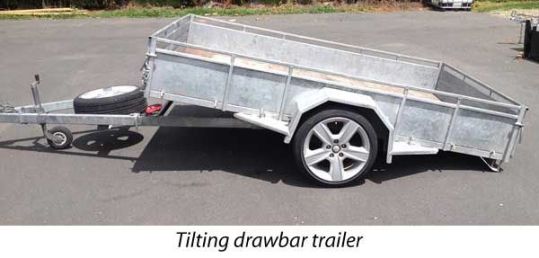Tilting / Breakneck Drawbars
Tilting or breakneck drawbars are a handy addition to your trailer if you are planning on transporting loose material (sand, soil, bark, rubbish, etc..). With a quick flick of a latch or two, and a push down on the back of the trailer, the rear of the trailer will tilt to the ground making removal of loads easier and less back breaking. Tilt drawbars can also be used for loading and unloading a ride on mower, a quad bike, motorbike or similar equipment.

For a tandem axle, the hinge may need to be forward of the front spring to allow sufficient tilting of the deck. The shorter the trailer deck is on a tandem trailer, the less the deck will tilt and tilts really only work well on trailers over 10’ (3050mm) in length. Tandem trailers with fixed suspension or torsion suspension do not allow the deck to tilt under most circumstances. To work effectively, tandem trailers require oscillating/rocker style suspension.
Latches can be manually opened and closed and you can find automatic spring loaded latches which will lock the deck in position when lowered back on the drawbar. The automatic style are recommended as it is easy to forget to latch the deck down after working up a sweat unloading the trailer.
It is also recommended to add extra strength to the rear light channel/cross member of the trailer as this area will get a beating dropping to the ground on a regular basis.
Depending on the latching arrangement, tilt drawbar trailers can be a bit noisy when towing empty from steel on steel vibration. Frequent maintenance checks should to be done around the hinge area and latches to check for loose or worn items.